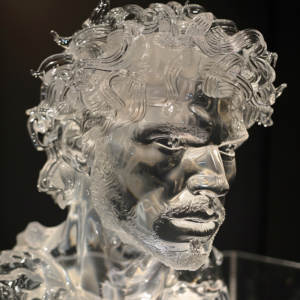Glass sculpting, with its captivating ability to manipulate light and form, transcends borders and cultures. Across the globe, artists are embracing this versatile medium to express their unique perspectives and cultural identities. Let’s embark on a captivating journey, exploring the diverse trends and artistic expressions that define glass sculpting around the world.
Europe: A Legacy of Innovation and Refinement
Europe boasts a rich history of glass sculpting, with countries like Italy, France, and the Czech Republic playing a pivotal role in its development. The Venetian glass tradition, with its mastery of color and intricate details, continues to inspire contemporary artists. European glass sculptors often focus on classical forms and techniques, pushing the boundaries of refinement and technical expertise. However, there’s also a growing movement towards conceptual art, with artists like Magdalena Abakanowicz (Poland) using glass to explore social and political themes.
North America: A Melting Pot of Styles and Techniques
North America is a melting pot of cultures, reflected in the diversity of its glass sculpting scene. American sculptors like Dale Chihuly are renowned for their large-scale installations that transform public spaces with vibrant colors and dynamic shapes. The emphasis on experimentation and pushing boundaries is evident in the works of artists like Josiah McElheny, who incorporates found objects and technology into his glass sculptures. The Studio Glass movement, born in the mid-20th century, continues to influence contemporary artists, promoting a focus on studio practice and individual expression.
Asia: A Fusion of Tradition and Modernity
Asian glass sculpting offers a captivating blend of traditional techniques and contemporary innovation. Japan boasts a rich history of glassblowing, with artists like Hiroshi Sugimoto creating mesmerizing sculptures that explore themes of light, shadow, and perception. Chinese glass sculptors often incorporate elements of their cultural heritage, such as calligraphy and traditional motifs, into their works. Korean artists like Kim Inkie are pushing the boundaries of the medium by creating large-scale, interactive glass installations that engage viewers in a unique way.
Latin America: Vibrant Colors and Expressive Forms
Latin American glass sculpting is characterized by its vibrant colors and expressive forms. Artists like Liliana Fonseca (Argentina) utilize glass to explore themes of identity, memory, and the natural world. Mexican glass sculptors often draw inspiration from their rich cultural heritage, incorporating pre-Columbian symbols and motifs into their works. The use of recycled glass is also gaining traction in Latin America, with artists like Javier Marín (Colombia) creating thought-provoking sculptures that address environmental concerns.
Africa: A Story of Resilience and Cultural Identity
African glass sculpting is a relatively young art form but is rapidly gaining recognition. Artists like John Vladis (South Africa) utilize glass to tell stories of resilience, cultural identity, and the African diaspora. The use of found objects and recycled materials is becoming a defining characteristic of African glass sculpting, reflecting the continent’s resourcefulness and ingenuity.
Conclusion: A Tapestry of Creativity
The journey through global glass sculpting trends reveals a tapestry of creativity, cultural expression, and artistic innovation. From the refined techniques of Europe to the bold experimentation of North America, from the fusion of tradition and modernity in Asia to the vibrant colors and expressive forms of Latin America and Africa, glass sculpting thrives as a universal language that transcends borders and speaks to the human spirit. As the art form continues to evolve, one thing remains certain: glass sculpting will continue to captivate audiences with its beauty, versatility, and power to tell stories and spark conversation.



